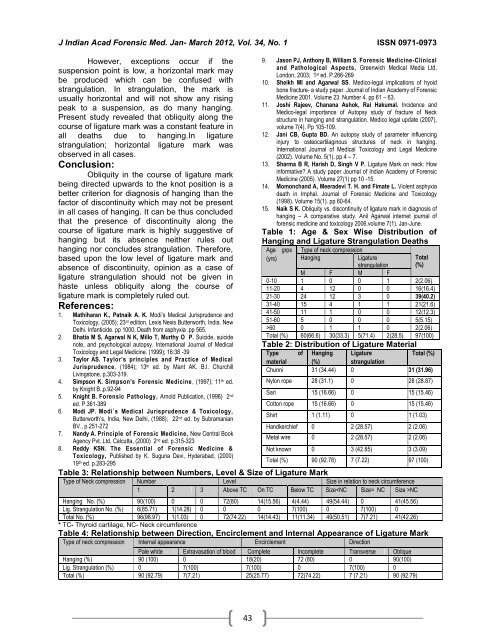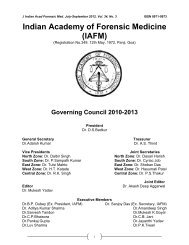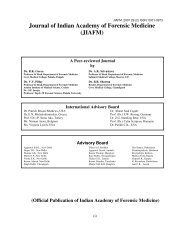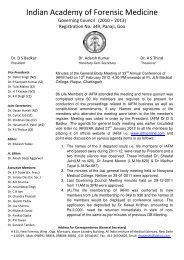Indian Academy of Forensic Medicine (IAFM) - Official website of IAFM
Indian Academy of Forensic Medicine (IAFM) - Official website of IAFM
Indian Academy of Forensic Medicine (IAFM) - Official website of IAFM
Create successful ePaper yourself
Turn your PDF publications into a flip-book with our unique Google optimized e-Paper software.
J <strong>Indian</strong> Acad <strong>Forensic</strong> Med. Jan- March 2012, Vol. 34, No. 1 ISSN 0971-0973<br />
However, exceptions occur if the<br />
suspension point is low, a horizontal mark may<br />
be produced which can be confused with<br />
strangulation. In strangulation, the mark is<br />
usually horizontal and will not show any rising<br />
peak to a suspension, as do many hanging.<br />
Present study revealed that obliquity along the<br />
course <strong>of</strong> ligature mark was a constant feature in<br />
all deaths due to hanging.In ligature<br />
strangulation; horizontal ligature mark was<br />
observed in all cases.<br />
Conclusion:<br />
Obliquity in the course <strong>of</strong> ligature mark<br />
being directed upwards to the knot position is a<br />
better criterion for diagnosis <strong>of</strong> hanging than the<br />
factor <strong>of</strong> discontinuity which may not be present<br />
in all cases <strong>of</strong> hanging. It can be thus concluded<br />
that the presence <strong>of</strong> discontinuity along the<br />
course <strong>of</strong> ligature mark is highly suggestive <strong>of</strong><br />
hanging but its absence neither rules out<br />
hanging nor concludes strangulation. Therefore,<br />
based upon the low level <strong>of</strong> ligature mark and<br />
absence <strong>of</strong> discontinuity, opinion as a case <strong>of</strong><br />
ligature strangulation should not be given in<br />
haste unless obliquity along the course <strong>of</strong><br />
ligature mark is completely ruled out.<br />
References:<br />
1. Mathiharan K., Patnaik A. K. Modi’s Medical Jurisprudence and<br />
Toxicology, (2005); 23 rd edition. Lexis Nexis Butterworth, India. New<br />
Delhi. Infanticide. pp 1000, Death from asphyxia .pp 565.<br />
2. Bhatia M S, Agarwal N K, Millo T, Murthy O P. Suicide, suicide<br />
note, and psychological autopsy. International Journal <strong>of</strong> Medical<br />
Toxicology and Legal <strong>Medicine</strong>. (1999); 16:38 -39<br />
3. Taylor AS. Taylor’s principles and Practice <strong>of</strong> Medical<br />
Jurisprudence, (1984); 13 th ed. by Mant AK. B.I. Churchill<br />
Livingstone, p.303-319.<br />
4. Simpson K. Simpson's <strong>Forensic</strong> <strong>Medicine</strong> , (1997); 11 th ed.<br />
by Knight B.,p.92-94<br />
5. Knight B. <strong>Forensic</strong> Pathology, Arnold Publication, (1996) 2 nd<br />
ed. P.361-389<br />
6. Modi JP. Modi`s Medical Jurisprudence & Toxicology,<br />
Butterworth’s, India, New Delhi, (1988); 22 nd ed. by Subramanian<br />
BV., p.251-272<br />
7. Nandy A. Principle <strong>of</strong> <strong>Forensic</strong> <strong>Medicine</strong>, New Central Book<br />
Agency Pvt. Ltd, Calcutta, (2000) 2 nd ed. p.315-323<br />
8. Reddy KSN. The Essential <strong>of</strong> <strong>Forensic</strong> <strong>Medicine</strong> &<br />
Toxicology, Published by K. Suguna Devi, Hyderabad, (2000)<br />
19 th ed. p.283-295<br />
43<br />
9. Jason PJ, Anthony B, William S. <strong>Forensic</strong> <strong>Medicine</strong>-Clinical<br />
and Pathological Aspects, Greenwich Medical Media Ltd,<br />
London, 2003; 1st ed. P.266-269<br />
10. Sheikh MI and Agarwal SS. Medico-legal implications <strong>of</strong> hyoid<br />
bone fracture- a study paper. Journal <strong>of</strong> <strong>Indian</strong> <strong>Academy</strong> <strong>of</strong> <strong>Forensic</strong><br />
<strong>Medicine</strong> 2001. Volume 23. Number 4. pp 61 – 63.<br />
11. Joshi Rajeev, Chanana Ashok, Rai Hakumal. Incidence and<br />
Medico-legal importance <strong>of</strong> Autopsy study <strong>of</strong> fracture <strong>of</strong> Neck<br />
structure in hanging and strangulation. Medico legal update (2007),<br />
volume 7(4). Pp 105-109.<br />
12. Jani CB, Gupta BD. An autopsy study <strong>of</strong> parameter influencing<br />
injury to osteocartilaginous structures <strong>of</strong> neck in hanging.<br />
13.<br />
International Journal <strong>of</strong> Medical Toxicology and Legal <strong>Medicine</strong><br />
(2002). Volume No. 5(1). pp 4 – 7.<br />
Sharma B R, Harish D, Singh V P. Ligature Mark on neck: How<br />
informative? A study paper Journal <strong>of</strong> <strong>Indian</strong> <strong>Academy</strong> <strong>of</strong> <strong>Forensic</strong><br />
<strong>Medicine</strong> (2005). Volume 27(1) pp 10 -15.<br />
14. Momonchand A, Meeradevi T. H. and Fimate L. Violent asphyxia<br />
death in Imphal. Journal <strong>of</strong> <strong>Forensic</strong> <strong>Medicine</strong> and Toxicology<br />
(1998). Volume 15(1). pp 60-64.<br />
15. Naik S K. Obliquity vs. discontinuity <strong>of</strong> ligature mark in diagnosis <strong>of</strong><br />
hanging – A comparative study. Anil Agarwal internet journal <strong>of</strong><br />
forensic medicine and toxicology 2006.volume 7(1). Jan-June.<br />
Table 1: Age & Sex Wise Distribution <strong>of</strong><br />
Hanging and Ligature Strangulation Deaths<br />
Age grps<br />
(yrs)<br />
Type <strong>of</strong> neck compression<br />
Hanging Ligature<br />
strangulation<br />
M F M F<br />
Total<br />
(%)<br />
0-10 1 0 0 1 2(2.06)<br />
11-20 4 12 0 0 16(16.4)<br />
21-30 24 12 3 0 39(40.2)<br />
31-40 15 4 1 1 21(21.6)<br />
41-50 11 1 0 0 12(12.3)<br />
51-60 5 0 0 0 5(5.15)<br />
>60 0 1 1 0 2(2.06)<br />
Total (%) 60(66.6) 30(33.3) 5(71.4) 2(28.5) 97(100)<br />
Table 2: Distribution <strong>of</strong> Ligature Material<br />
Type <strong>of</strong> Hanging Ligature<br />
Total (%)<br />
material<br />
(%)<br />
strangulation<br />
Chunni 31 (34.44) 0 31 (31.96)<br />
Nylon rope 28 (31.1) 0 28 (28.87)<br />
Sari 15 (16.66) 0 15 (15.46)<br />
Cotton rope 15 (16.66) 0 15 (15.46)<br />
Shirt 1 (1.11) 0 1 (1.03)<br />
Handkerchief 0 2 (28.57) 2 (2.06)<br />
Metal wire 0 2 (28.57) 2 (2.06)<br />
Not known 0 3 (42.85) 3 (3.09)<br />
Total (%) 90 (92.78) 7 (7.22) 97 (100)<br />
Table 3: Relationship between Numbers, Level & Size <strong>of</strong> Ligature Mark<br />
Type <strong>of</strong> Neck compression Number Level Size in relation to neck circumference<br />
1 2 3 Above TC On TC Below TC SizeNC<br />
Hanging No. (%) 90(100) 0 0 72(80) 14(15.56) 4(4.44) 49(54.44) 0 41(45.56)<br />
Lig. Strangulation No. (%) 6(85.71) 1(14.28) 0 0 0 7(100) 0 7(100) 0<br />
Total No. (%) 96(98.97) 1(1.03) 0 72(74.22) 14(14.43) 11(11.34) 49(50.51) 7(7.21) 41(42.26)<br />
* TC- Thyroid cartilage, NC- Neck circumference<br />
Table 4: Relationship between Direction, Encirclement and Internal Appearance <strong>of</strong> Ligature Mark<br />
Type <strong>of</strong> neck compression Internal appearance Encirclement Direction<br />
Pale white Extravasation <strong>of</strong> blood Complete Incomplete Transverse Oblique<br />
Hanging (%) 90 (100) 0 18(20) 72 (80) 0 90(100)<br />
Lig. Strangulation (%) 0 7(100) 7(100) 0 7(100) 0<br />
Total (%) 90 (92.79) 7(7.21) 25(25.77) 72(74.22) 7 (7.21) 90 (92.79)









